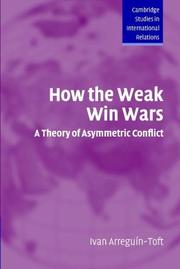| Listing 1 - 3 of 3 |
Sort by
|

ISBN: 9780521548694 9780521839761 0521839769 0521548691 9780511521645 0511839049 0511521642 Year: 2005 Volume: 99 Publisher: Cambridge Cambridge University Press
Abstract | Keywords | Export | Availability | Bookmark
 Loading...
Loading...Choose an application
- Reference Manager
- EndNote
- RefWorks (Direct export to RefWorks)
How do the weak win wars ? The likelihood of victory and defeat in asymmetric conflicts depends on the interaction of the strategies weak and strong actors use. Using statistical and in-depth historical analyses of conflicts spanning two hundred years, in this 2005 book Ivan Arreguin-Toft shows that, independent of regime type and weapons technology, the interaction of similar strategic approaches favors strong actors, while opposite strategic approaches favors the weak. This approach to understanding asymmetric conflicts allows us to makes sense of how the United States was able to win its war in Afghanistan (2002) in a few months, while the Soviet Union lost after a decade of brutal war (1979-89). Arreguin-Toft's strategic interaction theory has implications not only for international relations theory, but for policy makers grappling with interstate and civil wars, as well as terrorism.
Polemology --- World history --- anno 1900-1999 --- anno 1800-1899 --- Asymmetric warfare --- Military history, Modern --- #SBIB:327.5H20 --- Modern military history --- Military art and science --- Vredesonderzoek: algemeen --- Social Sciences --- Political Science --- Asymmetric warfare - Case studies --- Military history, Modern - Case studies
Book
ISBN: 9780313364709 9780313364716 0313364702 Year: 2009 Publisher: Westport: Praeger,
Abstract | Keywords | Export | Availability | Bookmark
 Loading...
Loading...Choose an application
- Reference Manager
- EndNote
- RefWorks (Direct export to RefWorks)
ASYMMETRIC WARFARE --- COUNTERINSURGENCY --- MASS MEDIA AND WAR --- DIGITAL MEDIA --- INFORMATION TECHNOLOGY --- Polemology --- Mass communications --- Asymmetric warfare - Case studies --- Guerrilla warfare - Case studies --- Military telecommunication - Case studies --- Information technology - Case studies --- Digital media - Case studies --- Insurgency - Case studies --- Counterinsurgency - Case studies --- Irregular warfare - Case studies --- Asymmetric warfare --- Guerrilla warfare --- Military telecommunication --- Information technology --- Digital media --- Insurgency --- Counterinsurgency --- Irregular warfare
Book
ISBN: 9780833058508 0833058509 0833058533 9780833058539 Year: 2011 Publisher: RAND Corporation
Abstract | Keywords | Export | Availability | Bookmark
 Loading...
Loading...Choose an application
- Reference Manager
- EndNote
- RefWorks (Direct export to RefWorks)
Like Israel in 2006, the United States today is likely ill prepared for hybrid warfare. To identify lessons that the U.S. military might learn from the Israeli experience in Lebanon, the author examines the state of the Israeli military before the Second Lebanon War, the lessons it learned during that conflict, the reforms it undertook to address its deficiencies, and how it fared during Operation Cast Lead three years later.
#SBIB:327.5H21 --- #SBIB:328H513 --- #SBIB:328H514 --- Vrede – oorlog, oorlogssituaties --- Instellingen en beleid: Palestijnen --- Instellingen en beleid: Israël --- Asymmetric warfare -- Case studies. --- Gaza War, 2008-2009. --- Israel. Tseva haganah le-YiśraÊ1⁄4el. --- Lebanon War, 2006. --- United States -- Military policy. --- Asymmetric warfare --- Gaza War, 2008-2009 --- Cast Lead, Operation, 2008-2009 --- Gaza Strip War, 2008-2009 --- Operation Cast Lead, 2008-2009 --- Hezbollah-Israel War, 2006 --- Israel-Hezbollah War, 2006 --- Israel-Lebanon War, 2006 --- July War, 2006 --- Lebanon-Israel War, 2006 --- Second Lebanon War, 2006 --- I.D.F. --- IDF --- Israel Defense Forces --- Israeli Defense Force --- Israeli Defense Forces --- Tsahal --- Tzahal --- Zahal --- צבא --- צבא הגנה לישראל --- צה׳׳ל --- ישראל. --- Lebanon War, 2006 --- Arab-Israeli conflict --- Military art and science --- Israel. --- Haganah (Organization) --- United States --- Military policy.
| Listing 1 - 3 of 3 |
Sort by
|

 Search
Search Feedback
Feedback About UniCat
About UniCat  Help
Help News
News